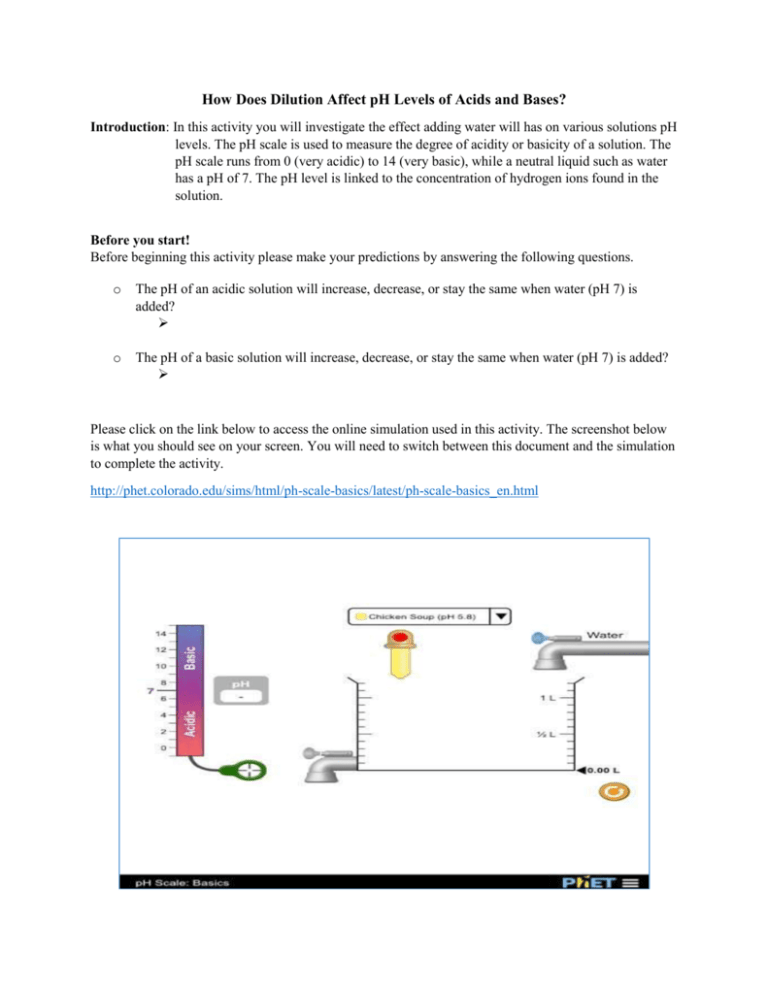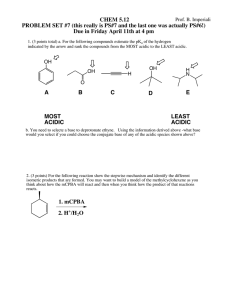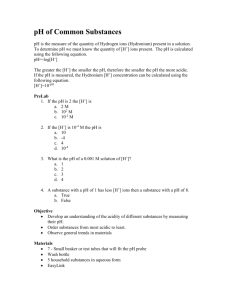Phet pH Scale Basics Worksheet
advertisement

How Does Dilution Affect pH Levels of Acids and Bases? Introduction: In this activity you will investigate the effect adding water will has on various solutions pH levels. The pH scale is used to measure the degree of acidity or basicity of a solution. The pH scale runs from 0 (very acidic) to 14 (very basic), while a neutral liquid such as water has a pH of 7. The pH level is linked to the concentration of hydrogen ions found in the solution. Before you start! Before beginning this activity please make your predictions by answering the following questions. o The pH of an acidic solution will increase, decrease, or stay the same when water (pH 7) is added? o The pH of a basic solution will increase, decrease, or stay the same when water (pH 7) is added? Please click on the link below to access the online simulation used in this activity. The screenshot below is what you should see on your screen. You will need to switch between this document and the simulation to complete the activity. http://phet.colorado.edu/sims/html/ph-scale-basics/latest/ph-scale-basics_en.html Exploration Phase 1. Experiment with the various solutions from the drop box. Click and hold the eye dropper to add a desired amount of the selected fluid into the beaker. 2. Practice adding various amounts of solutions as well as water from the nozzle lever. 3. Click on the drainer to empty either some or all of the solution or to start a new experiment. Questions 1. From the drop box, what is the most acidic substance in this simulation? What is its pH value? 2. From the drop box, what is the most basic substance in this simulation? What is its pH value? 3. What substance(s) have a pH most similar to that of water (pH 7)? 4. What two substances have the same pH value? Why might this be? 5. Being that vomit has a pH of 2.0, would you believe the human stomach be an acidic or basic environment? Why might this be? Explanation Phase Use the simulation to fill in the following table, using the drain cleaner example that is already completed for you as a guide. You will be testing the pH of five solutions before and after adding various amounts of pure water to test how dilution affects pH levels. This will be done by placing the green detector into the beaker’s solution after adding the appropriate amount of each liquid. In this experiment you will be testing five substances, along with three dilution levels of each substance when combined with water. Each solution should be 1.0 Liter (see image below) when testing. After each experiment it is important to drain the entire solution before beginning your next experiment. Aim: Create a rule that describes what happens when pure water is added to various acidic and basic substances. Substance Name pH of Pure Substance (100%) Is it an acidic or basic substance? Drain Cleaner 13.0 Basic 0.75 L of substance 0.25 L of water 1.0 L total 12.88 0.50 L of substance 0.50 L of water 1.0 L total 12.69 0.10 L of substance 0.90 L of water 1.0 L total 12.00 Is the final solution an acid or base? Base Application Phase 1. What happens to the pH of acidic solutions as you add water? 2. What happens to the pH of basic solutions as you add water? 3. In general, when we dilute and acid or a base, the pH always moves toward what pH value? 4. Did an acid ever become a base or did a base ever become an acid? Why do you think so? Conclusion Create a rule that describes what happens when water is added to various acidic and basic substances. Suggest why, no matter how much we dilute an acid with water, the pH never rises above 7. o Suggest why, no matter how much we dilute a base with water, the pH never falls below 7. o Were you surprised with any of your findings during this simulation? If so, what were you surprised to see? o











